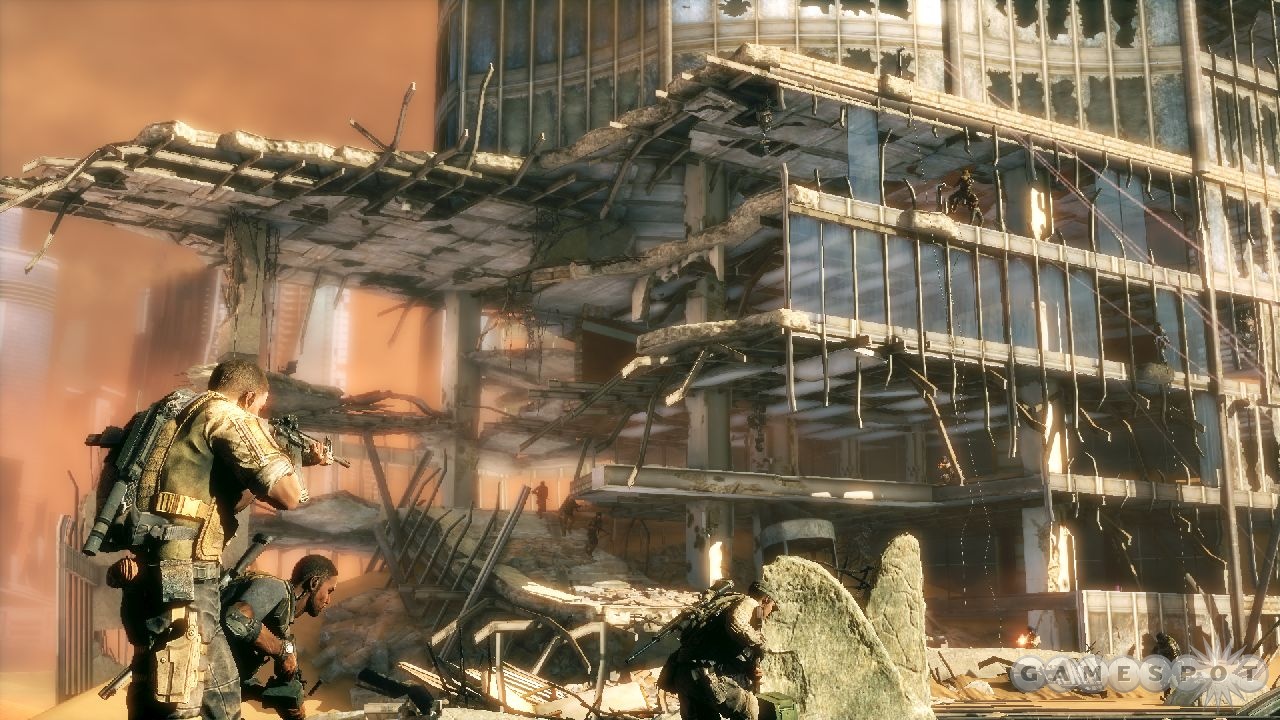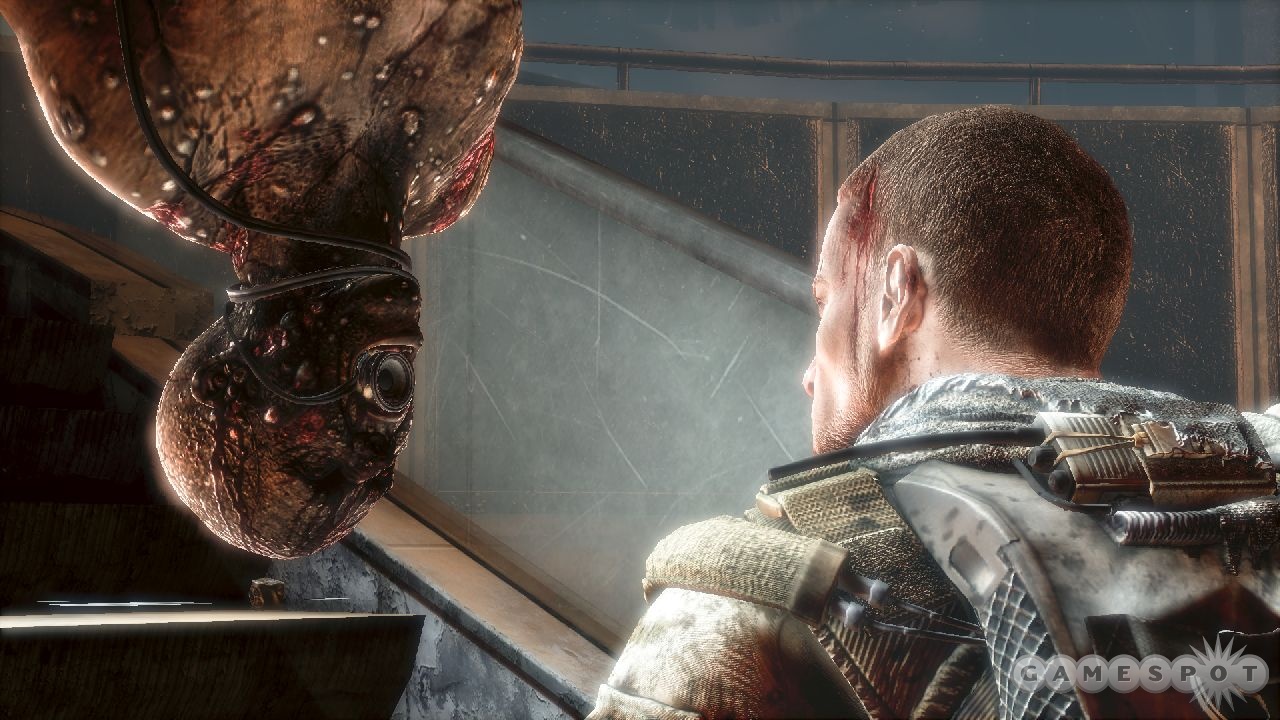Spec Ops: The Line Morality and Murder Preview
We wiggle our toes in the sand and get our hands on this long-thought-MIA shooter.

Command, we're on the move. The radio squawks to life as the harsh golden sun beats down from high in the sky on our camouflaged backs. Delta Recon squad trudges on through the cascading sandy dunes of Dubai. After natural disaster strikes this once opulent desert oasis, the shadow the city casts changes from one of glitzy architectural marvels and luxury vehicles to a sullied skyline of dilapidated buildings and hanging bodies. Not exactly the holiday destination they sold us in our brochure.
STAR WARS: Prequel Pack - Official Reveal Trailer DEAD OR ALIVE Xtreme Venus Vacation PRISM - Official 2nd Trailer Phantom Blade Zero - 6 Minute "Year of the Snake" Gameplay Trailer The Hundred Line -Last Defense Academy-: Character Trailer 1 Black Ops 6 & Warzone - Official Season 02 Launch Trailer GUILTY GEAR STRIVE: DUAL RULERS - Official Main Trailer Marvel Rivals | The Spring Festival Trailer Kingdom Come: Deliverance 2 Roadmap Trailer Zenless Zone Zero - Astra Yao Character Demo | "Ridu Holidays" BlazBlue Entropy Effect - Hazama Character DLC Gameplay Reveal Trailer Helskate Launch Trailer Code Violet | Announcement Trailer
Please enter your date of birth to view this video
By clicking 'enter', you agree to GameSpot's
Terms of Use and Privacy Policy
Like the military unit at the centre of its narrative, Spec Ops: The Line had dropped off the radar of late; its most recent public appearance was at the 2010 Electronic Entertainment Expo. Though the game truly earned its MIA status, the project is anything but finished, and we recently had the chance to pick up the controller and take Captain Martin Walker and the Deltas into battle. As a brief recap, you play as a three-man unit in search of missing Colonel John Konrad, who disappeared along with his team, the 33rd, after a humanitarian sandstorm extraction mission went pear shaped.
No war shooter would be complete without a chopper flight, and as the first scene of our demo opened, we found ourselves manning that familiar position at a mounted machine gun. Combatant helis buzzed around our ears and dodged buildings like giant metallic flies, and we did our duty, swatting them from the heavens by plugging them full of gunfire, setting them alight, and watching as they crashed and burnt.
Boots on the ground, we began our walk towards what was left of civilisation; a tattered, upside-down flying American flag welcomed us and provided a foreboding warning of what was to come. Rolls-Royces and Ferraris lay abandoned and wrecked, creating a natural gauntlet, and our senses heightened as the watchful eyes of unknown assailants tracked our movements from behind cover. We were quickly set on by bad dudes, and out came the weapons. Gunplay in this third-person shooter will be immediately familiar to anyone who has played games such as Gears of War, Army of Two, or Dead Space. The influences are worn proudly on Spec Ops' sleeve like so many decorated war medals. Besides the button-press cover mechanic and vaulting over low-slung objects, executions are performed on downed enemies with a button press, while dynamic interface elements slide onto the screen when you're performing combat actions, such as dealing headshots with particular weapons, or when picking up in-game collectibles, called Intel. Reclaiming the latter plays audio dossiers on your own squadmates and recordings from locals who have become caught in the crossfire.

Aboard a downed plane we breached a doorway, causing time to slow, and watched as enemies flailed arms and fumbled for their weapons, or attempted to dive for cover. We shot them all in the face. An American soldier being held captive survived the fight, but only just. As we rushed to his aide, he was barely able to mutter a mention of something called The Nest before slipping away. We headed north in search of our next stop.
You operate as a small team alongside Sergeant John Lugo and Lieutenant Alphonso Adams, but you only ever directly control Walker. That doesn't mean your sidekicks are just along for the ride, and by tapping the right bumper you can bring up a support targeting system used to designate enemies you want taken out. We found this particularly useful for ranged targets where iron sights didn't provide enough reach. You can't paint multiple targets, so there's an element of micromanagement as you keep yourself alive and give orders, but left to their own devices they lend a hand reasonably well. Unfortunately, while targets glow red when they can be selected, because the marker is relative to their physical proximity to you, it can be tough to spot small red dots that represent snipers at long ranges in the heat of battle. Likewise, enemies who duck behind cover or break line-of-sight with you often need to be waited on until they pop up to be targeted, in some cases making it simpler for you to shoot them yourself rather than wait on your team to do the dirty work.
We fired our fair share of weapons during the hour-long play, with each having its own distinctive personality. The Scout rifle features a variable zoom scope; the SCAR packs an under-barrel grenade launcher that is useful for clearing groups of shy hiders; the M4A1 has a silencer attachment for covert takedowns; and the brutal AK-47 makes its presence and power known with every cracking round shot and hefty recoil.
While exploring The Nest, we came across a large building complex complete with barricaded walkways, dangerously slanted corridors, and kickable doors (soldiers don't use handles), which we fell through, sliding down a slope and landing separated from the rest of our group. Our major weapons were lost in the fall, leaving us with only a pistol. After a couple of quick hand-to-hand beatdowns and shoot-outs, we quickly restocked our gun sack. Adams and Lugo took their sweet time making their way down to our position, and after clearing a small group of soldiers, we got the requisite turret holdout mission as waves of attackers streamed in from behind a shipping crate. We could do it all on our own, but in the interest of sharing the fun, we painted targets in the distance for our rifle-packing sidekick to take potshots at. Team AI accuracy was good, and provided they could see what they were shooting at, they got the job done--though we did the bulk of the work.

Gamers are no strangers to the atrocities of war, but Spec Ops hopes that there's still some room to shock you with a mature approach to confronting and impactful scenes. One room in particular shelved the hard rock soundtrack to strike up an orchestral score. With the option to run removed, we were forced to slowly step through a bloody, corpse-filled room. Further on, a body hung from a noose with a speaker in its mouth, piping prerecorded screams through the echoing cement tomb housing it. Another space held half a dozen bodies with scorched flesh, victims of the (Geneva Convention's illegal) use of white phosphorous weapons.
The final scene of our hands-on demo showcased one of the game's many moral crossroads. Scenarios will crop up throughout the game that force you to either continue along the path of the main mission or complete other tasks. They're not side missions per se, but in many cases ignoring them is a decision in its own right and forces you to deal with the consequences of your inaction. Likewise, your two teammates will respond to you accordingly as a result of the decisions you make (or don't make) and the orders you give. Moving into a clearing, we came across two more hanging bodies, though these were alive. One was a civilian accused of stealing water, while the other was a soldier who had been sent to arrest the man, but had killed five family members of the accused in the process. We won't spoil any of the possible outcomes, but there are more options than may otherwise appear to be available at first glance. These sorts of decisions are a refreshing change to the illusion of choice provided in so many games by choosing option A or B, and the added pressure of time sensitivity that gives your actions and reasoning urgency. Our only concern, and one we're hoping is addressed early in the game, is spelling out the more free-form nature of the choices available, lest players be unaware of what they can and can't do within the confines of the gameworld.
This game leans away from the military simulations of its competition in favour of a more loose action adventure style. Weapons won't jam as they fill with the elements, military vernacular synonymous with the genre such as "Oscar Mike" instead of "on the move" isn't featured, and a clear emphasis is being put on the story as much as the action. We like what we've seen of Spec Ops: The Line so far and welcome more mature approaches to wargames. We'll have more on the game as it approaches its autumn 2012 Australian release on the Xbox 360, PlayStation 3, and PC.
Got a news tip or want to contact us directly? Email news@gamespot.com
Join the conversation